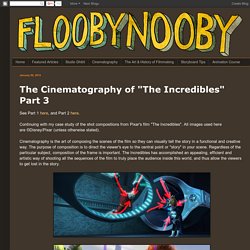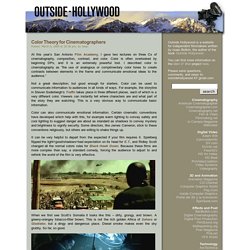

Lighting principles. Youtube. Roger Deakins, ASC, BSC. Phil Straub Composition Tutorial. Sun 4th Dec 2005, by Phil Straub | Tutorial This article was written by Phil Straub back in 2005, and it is as fresh and vital today as it was then.

Phil’s tips and trick are timeless, and can help you make your images pop! Composition is everything! No amount of detail in an illustration or Concept Painting will be successful without a strong composition foundation. Composition in Environment Concept painting can be quite difficult since your focal point usually isn’t as obvious as in a character piece. DIVINE PROPORTIONS: The Golden Rule and Rule of Thirds When you take the canvas area and divide it into ‘thirds’ Horizontally and Vertically, where the lines cross in the picture area is a ‘Golden Mean’, or the best spot in which to place your Main Subject or Object of Interest as it is the Focal Point of your picture. The golden rule can and usually is applied to a paintings canvas proportions.
The Rule of Thirds Implied Forms The Circle. Guide du Digital Painting #7 : La Couleur. Dans ce septième opus, nous développerons le thème de la couleur car bien savoir peindre la couleur et maîtriser certaines règles est primordial.

Comprendre la couleur, par Andrew Price. Matthew Scott Cinematography Blog. NOTE: If you enjoy this breakdown, please also check out my newest edition for Inglourious Basterds HERE :) Can you imagine being a chef and going out for dinner to a new restaurant?

Or a builder who's looking to buy a new home? What are they looking for in a meal? Or a house? I think it's natural for anyone passionate in their field to study and enjoy the work of their peers, but sometimes it gets in the way of the experience. I recently watched PRISONERS, written by Aaron Guzikowski, Directed by Denis Villeneuve and shot by the cinematographer I admire the most, Roger Deakins ASC (visit his amazing cinematography site). Not only was I completely glued to the screen and scrambling for clues to solve the case, but nearly every single scene had me looking with awe at the masterful cinematography and film-making craftsmanship that was before me on screen. Please keep in mind that I had nothing to do with this film! Flooby Nooby: The Cinematography of "The Incredibles" Part 3. See Part 1 here, and Part 2 here.Continuing with my case study of the shot compositions from Pixar's film "The Incredibles".

All images used here are ©Disney/Pixar (unless otherwise stated). Cinematography is the art of composing the scenes of the film so they can visually tell the story in a functional and creative way. The purpose of composition is to direct the viewer's eye to the central point or "story" in your scene. Art Fundamentals - Chapter 1 by Ioan Dumitrescu. Understanding Composition. I once thought “I already know the rule of thirds, so I’m good.”

But it wasn’t until reading countless books that I learned that it’s so much more. And once you’ve learned this you’ll never use Blender the same way again. I made this video because I don’t want you to make the same mistake I did – wasting 8 years of your life creating dull scenes that lack proper composition. Composition is one of the most things you can learn as a CG artist, and yet almost no one in the CG field is teaching it.
2. White balance: Adorama photography TV. The Cinematography of "The Lego Movie" - Expanded Cinematography. Color Theory for Cinematographers - Outside Hollywood. At this year’s San Antonio Film Academy, I gave two lectures on three Cs of cinematography, composition, contrast, and color.

Color is often overlooked by beginning DPs, and it is an extremely powerful tool. I described color in cinematography as “the use of analogous or complimentary color tones to create contrasts between elements in the frame and communicate emotional ideas to the audience.” Not a great description, but good enough for starters.
Color can be used to communicate information to audiences in all kinds of ways. For example, the storyline in Steven Soderbergh’s Traffic takes place in three different places, each of which is a very different color. Color can also communicate emotional information. It can be very helpful to depart from the expected if your film requires it. When we first see Scott’s Somalia it looks like this – dirty, grungy, and brown. By contrast, US soldiers live in high-tech steel barracks lit by cool halogen lights and laptop screens. The Ultimate Guide to Composition - Part One: Just Say "No"keh.
Note: This is Part One.

For Part Two: Beyond the Basics, click here. Composition – it’s perhaps one of the most important elements of photography. And with today’s technological marvels in lenses, it’s an even easier thing to forget – especially when bokehliciousis is so much more fun to talk about. Your composition is how you see – and that makes it infinitely more important than how out of focus the background is. 1. Color Temperature & Color Rendering Index DeMystified. 1. Color Temperature and white balance.